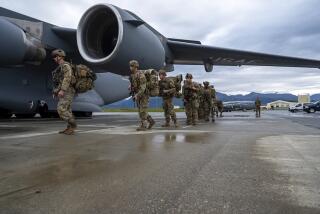Troops leave for Persian Gulf
- Share via
CORONADO — With their maze of aging pipes and narrow catwalks high above the Persian Gulf, they look like something out of “Waterworld,” Kevin Costner’s post-apocalyptic vision of the future.
Their names too seem lifted from a sci-fi flick: ABOT and KAAOT.
But the two Iraqi oil platforms 20 miles off the port of Umm al Qasr are considered tempting targets for terrorists thirsting to traumatize the world’s oil supply and short-circuit Iraq’s march to self-sufficiency.
So 340 sailors and Coast Guardsmen deployed Tuesday from North Island Naval Air Station in Coronado to take over security duties for the platforms, the northern reach of the Persian Gulf and the inland waterway that separates Iraq and Kuwait.
“The threat is emerging. The threat is changing,” Coast Guard Rear Adm. Mike Seward told the departing group. “You have to stay on the top of your game.”
The 340 are from the Navy’s Maritime Expeditionary Security Squadron One, with sailors from units in San Diego, San Pedro, Seal Beach, Portland and San Antonio and Coast Guardsmen from Long Beach. About 85% are reservists, 15% active-duty.
Petty Officer Kerry Salmons, 43, a Navy reservist, is a mathematics and science teacher at Wilmington Middle School in the Los Angeles Unified School District.
He and his wife, Marian, embraced. “I’m missing him already,” she said.
In 2004 an explosive-laden speedboat raced toward one of the platforms and was thwarted by U.S. military personnel and Iraq Oil Ministry guards. Two sailors and a Coast Guardsman were killed when the boat exploded short of its target.
Although it may seem a backwater of the U.S. mission in Iraq, security of the two oil platforms remains a top priority. U.S. Navy Secretary Donald Winter calls the terminals the “vital nerve center of the entire Iraqi economy.”
The long-range goal is to turn security over to the Iraqis, but that goal is not yet in sight.
The Al Basra Oil Terminal, called ABOT, and Khawr al Amaya Oil Terminal, or KAAOT, can pump 1.7 million barrels a day into tankers. More than 90% of Iraqi’s oil is loaded from the two terminals.
The region is so thick with boats of all varieties that sailors refer to it as Thunder Valley. The U.S. declines to discuss whether there have been more attacks on the platforms since the 2004 assault.
“We tell the guys that we’re one bad day from making the news,” said Navy Cmdr. Charles Sullivan, 46.
“In force protection, it’s a good day when nothing happens.”
The deployment will last at least six months.
“The sooner he goes out there, the sooner he gets back,” said Sullivan’s wife, Louise.
After the speeches by admirals and a final check of the gear, the troops loaded aboard the chartered plane and it lumbered down the runway and into the cool night as families watched.
“It comes with the territory for military families, watching loved ones go away,” said Janet Lawrence, wife of Petty Officer David Lawrence.
“But it’s never easy.”
--
More to Read
Sign up for Essential California
The most important California stories and recommendations in your inbox every morning.
You may occasionally receive promotional content from the Los Angeles Times.












